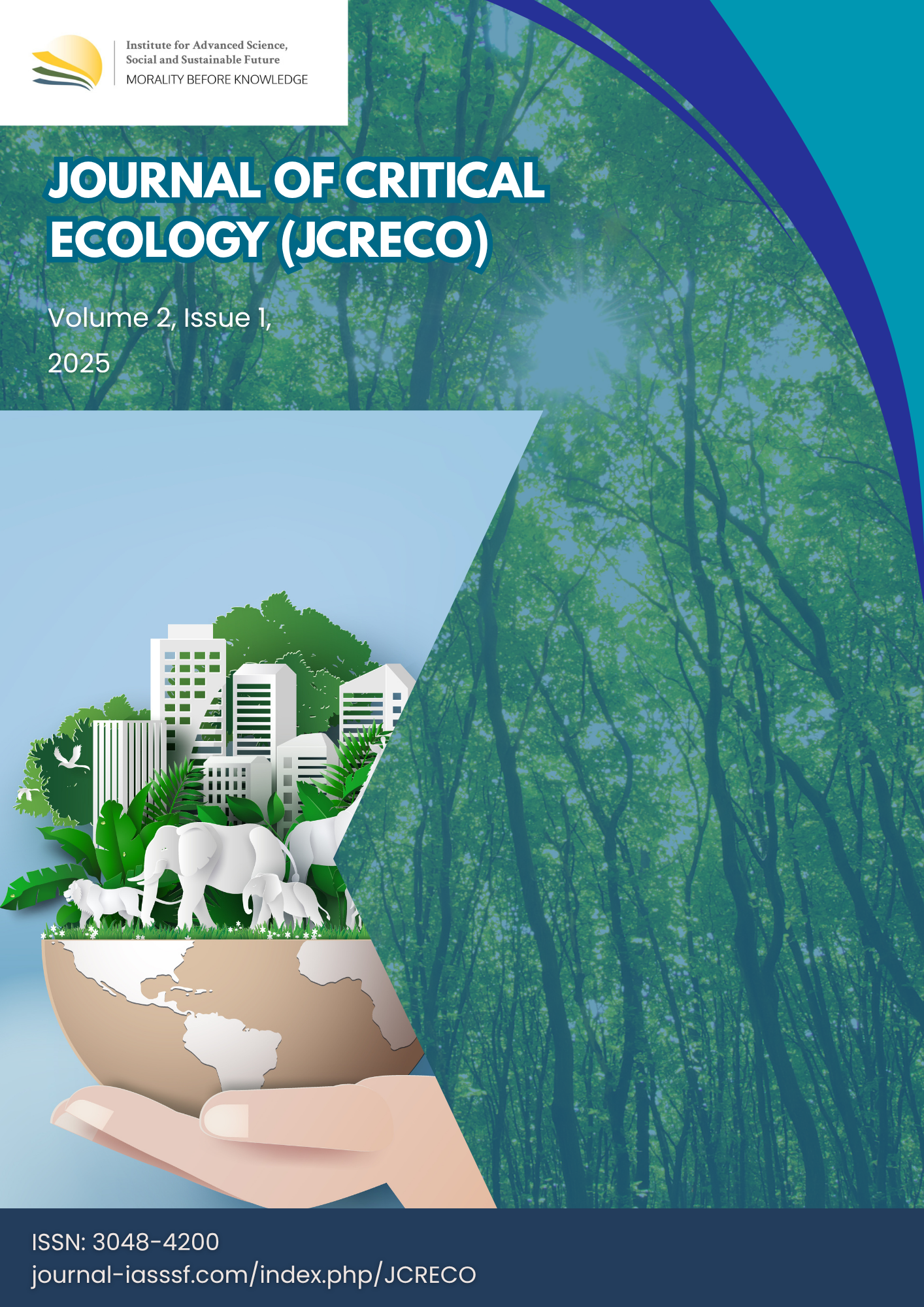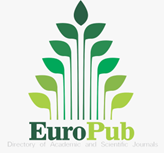Biocentrism and its role in shaping conservation approaches in protected areas
DOI:
https://doi.org/10.61511/jcreco.v2i1.1740Keywords:
anthropocentrism, biocentrism, ecocentrism, ecology, protected-areas prioritizationAbstract
Background: This study explores the shift from anthropocentrism to ecocentrism in the context of protected-area prioritization in Indonesia, highlighting the influence of deep ecology and biocentrism on human-environment relationships. The primary objective of the study is to analyze the impact of deep ecology and biocentrism on conservation efforts in Indonesia, offering insights into the challenges of integrating these philosophies into environmental policymaking for long-term biodiversity conservation. Methods: This study employs a literature review methodology, analyzing existing research, philosophical frameworks, and case studies related to anthropocentrism, biocentrism, and ecocentrism in the context of environmental ethics and protected-area management. The review includes works on deep ecology, environmental ethics, and Indonesia’s specific environmental policies, drawing from both global and local perspectives to examine how these philosophies shape conservation strategies. Findings: Anthropocentrism, which views nature primarily as a resource for human use, has historically shaped environmental policies, often resulting in environmental degradation and biodiversity loss. In contrast, ecocentrism and biocentrism, which recognize the intrinsic value of all life forms, advocate for a more ethical and sustainable approach to conservation. As one of the most biodiverse countries in the world, Indonesia faces significant challenges in balancing development with biodiversity conservation, particularly in light of pressures from deforestation, agriculture, and urbanization. Conclusion: By adopting ecocentric values, Indonesia can ensure that its protected areas are managed in a way that promotes the sustainability of both human and natural systems. Novelty/Originality of This Study: This study introduces a novel approach by integrating deep ecology and biocentrism into protected-area prioritization in Indonesia. It offers fresh insights into how these ethical frameworks can reshape conservation policies for long-term biodiversity sustainability.
References
Bhattacharjee, G., & Debnath, M. (2021). Anthropocentrism vs. Biocentrism: A Study on Human-Nature Relationship. North Asian International Research Journal of Social Science and Humanities, 7(3), 17–23. https://philarchive.org/rec/BHAAVB
BPS. (2022). Jumlah Kawasan Konservasi Perairan (Hektar), 2020. https://www.bps.go.id/id/statistics-table/2/MTI4OSMy/jumlah-kawasan-konservasi-perairan.html
BPS. (2024). Luas Kawasan Hutan dan Kawasan Konservasi Perairan Indonesia Berdasarkan Surat Keputusan Menteri Lingkungan Hidup dan Kehutanan, 2017-2022. https://www.bps.go.id/id/statistics-table/1/MTcxNiMx/luas-kawasan-hutan-dan-kawasan-konservasi-perairan-indonesia-berdasarkan-surat-keputusan-menteri-lingkungan-hidup-dan-kehutanan--2017-2021.html
Bracci, E., & Maran, L. (2013). Environmental management and regulation: Pitfalls of environmental accounting? Management of Environmental Quality: An International Journal, 24(4), 538–554. https://doi.org/10.1108/MEQ-04-2012-0027
Burchett, K. (2014). Anthropocentrism and nature. An attempt at reconciliation. Teoria, 2014(2),119–137. https://philosophy.as.uky.edu/sites/default/files/faculty_publications/Anthropocentrism_and_Nature_An_Attempt_at_Reconciliation_Burchett_Kyle.pdf
Chapron, B. G., Epstein, Y., & López-Bao, J. V. (2019). A rights revolution for nature. Science, 363(6434), 1392–1393. https://doi.org/10.1126/science.aav5601
Comstock, G. L. (1995). Do agriculturalists need a new, an ecocentric, ethic? 1994 Presidential address to the agriculture, food, and human values society. Agriculture and Human Values, 12(1), 2–16. https://doi.org/10.1007/BF02218070
Daniels, P., Bradshaw, M., Shaw, D., Sidaway, J., & Hall, T. (2016). An Introduction to Human Geography (5th ed.). Pearson.
Drenthen, M. (2011). Ecocentrism as Anthropocentrism. Ethics, Policy and Environment, 14(2), 151–154. https://doi.org/10.1080/21550085.2011.578365
Elnizar, N. E. (2018). Strict Liability, Jurus Ampuh Hukum Lingkungan Menjerat Korporasi Tanpa Buktikan Unsur Kesalahan. https://www.hukumonline.com/berita/a/strict-liability--jurus-ampuh-hukum-lingkungan-menjerat-korporasi-tanpa-buktikan-unsur-kesalahan-lt5aa77cdf71ead/
Enger, E., & Smith, B. F. (2006). Environmental Science: A Study of Interrelationship. McGraw Hill.
European Parliament. (2020). Resolution of 16 January 2020 on the 15th meeting of the Conference of Parties (COP15) to the Convention on Biological Diversity (2019/2824(RSP)). https://www.europarl.europa.eu/doceo/document/TA-9-2020-0015_EN.html
Gorke, M. (2003). The Death of Our Planet’s Species: A Challenge to Ecology and Ethics. Island Press.
Guczalska, K. (2023). Ecocentrism. Hopes and concerns. Scientific Papers of Silesian University of Technology Organization and Management Series, 2023(183). https://doi.org/10.29119/1641-3466.2023.183.10
Helmi. (2011). Hukum Lingkungan dalam Negara Hukum Kesejahteraan Untuk Mewujudkan Pembangunan Berkelanjutan. Inovatif: Jurnal Ilmu Hukum, 4(5), 100.
Kopnina, H. (2016). Half the earth for people (or more)? Addressing ethical questions in conservation. Biological Conservation, 203, 176–185. https://doi.org/10.1016/j.biocon.2016.09.019
Kopnina, H., Washington, H., Taylor, B., & Picolo, J. (2021). Anthropocentrism: More than Just a Misunderstood Problem. The International Journal of Ecopsychology (IJE), 3(1). https://digitalcommons.humboldt.edu/ije/vol3/iss1/4
Kotzé, L. J. (2014). Rethinking Global Environmental Law and Governance in the Anthropocene. Journal of Energy & Natural Resources Law, 32(2), 121–156. https://doi.org/10.1080/02646811.2014.11435355
Locke, H. (2013). Nature needs half: A necessary and hopeful new Agenda for protected areas. Parks, 19(2), 13–22. https://doi.org/10.2305/IUCN.CH.2013.PARKS-19-2.HL.en
Loreau, M. (2004). Does functional redundancy exist? Oikos, 104(3), 606–611. https://doi.org/10.1111/j.0030-1299.2004.12685.x
Macer, D. R. J. (1998). Bioethics is Love of Life: An Alternative Text Book. Eubios Ethics Institute. https://www.eubios.info/BLL.htm
Megwai, G., Njie, N. I., & Richards, T. (2016). Exploring green economy strategies and policies in developing countries. International Journal of Green Economics, 10(3–4), 338–357. https://doi.org/10.1504/IJGE.2016.081905
National Parks Association of Queensland Inc. (2024). Protected Areas In Indonesia. https://npaq.org.au/protected-areas-in-indonesia/
Piccolo, J. J. (2017). Intrinsic values in nature: Objective good or simply half of an unhelpful dichotomy? Journal for Nature Conservation, 37, 8–11. https://doi.org/10.1016/j.jnc.2017.02.007
Pimm, S. L., Jenkins, C. N., Abell, R., Brooks, T. M., Gittleman, J. L., Joppa, L. N., Raven, P. H., Roberts, C. M., & Sexton, J. O. (2014). The biodiversity of species and their rates of extinction, distribution, and protection. Science, 344(6187). https://doi.org/10.1126/science.1246752
Rae, G. (2016). Anthropocentrism. In Encyclopedia of Global Bioethics (pp. 146–155). Springer International Publishing. https://doi.org/10.1007/978-3-319-09483-0_24
Rosa, R. de la. (2014). Anthropocentric Ecocentrism: Why Anthropocentrism is Compatible with an Environmentally Centered Ethics? Phavisminda, 13, 17–32.
Roy, K. C., & Tisdell, C. A. (1999). Conservation and prudent management are the key to the preservation of the environment: The case of water resources, and the Indian situation. International Journal of Social Economics, 26(1–3), 274–289. https://doi.org/10.1108/03068299910229622
Rülke, J., Rieckmann, M., Nzau, J. M., & Teucher, M. (2020). How ecocentrism and anthropocentrism influence human-environment relationships in a kenyan biodiversity hotspot. Sustainability (Switzerland), 12(19), 8213. https://doi.org/10.3390/su12198213
Spínola, H. (2024). Ecocentric and anthropocentric worldviews: are they incompatible? Journal of STEAM Education, 7(2), 146–158. https://doi.org/10.55290/steam.1395926
Suhendra, D., Yahya, A., Faisal, Suhaimi, & Syarifuddin. (2019). How Effective is the Environmental Law for the Conservation of the Leuser Ecosystem Area in Indonesia? Advances in Social Science, Education and Humanities Research, 413, 61–67. https://doi.org/10.2991/assehr.k.200306.182
Surmeli, H., & Saka, M. (2013). Preservice Teachers’ Anthropocentric, Biocentric, and Ecocentric Environmental Ethics Approaches. 5(5), 159–163. https://doi.org/10.7813/2075-4124.2013/5-5/B.23
Taylor, B., Chapron, G., Kopnina, H., Orlikowska, E., Gray, J., & Piccolo, J. J. (2020). The need for ecocentrism in biodiversity conservation. Conservation Biology, 34(5), 1089–1096. https://doi.org/10.1111/cobi.13541
Taylor, B., Van Wieren, G., & Zaleha, B. D. (2016). The Greening of Religion Hypothesis. Social Science Quarterly , 30(5), 1000–1009. https://doi.org/10.1111/cobi.12735.
Thompson, J. (2001). Environmentalism: Philosophical Aspects. In International Encyclopedia of the Social & Behavioral Sciences (pp. 4679–4685). Elsevier Ltd.
Umar, F., & Winarso, H. (2022). Planning Theory and Environmental Ethics: Towards the Integration of Biodiversity and Urban Planning. Jurnal Wilayah Dan Lingkungan, 10(1), 15–29. https://doi.org/10.14710/jwl.10.1.15-29
UNEP-WCMC. (2024). Protected Area Profile for Indonesia from the World Database on Protected Areas, October 2024.
Washington, H., Taylor, B., Kopnina, H., Cryer, P., & Piccolo, J. J. (2017). Why ecocentrism is the key pathway to sustainability. The Ecological Citizen, 1(1), 35–41. https://www.ecologicalcitizen.net/pdfs/v01n1-08.pdf
Whaley, L. (2018). Geographies of the Self: Space, Place, and Scale Revisited. Human Arenas, 1, 21–36. https://doi.org/10.1007/s42087-018-0006-x
Downloads
Published
Issue
Section
Citation Check
License
Copyright (c) 2025 Kevin Ibrahim Suryo

This work is licensed under a Creative Commons Attribution 4.0 International License.















